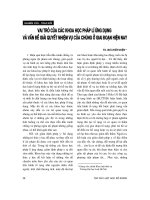Slide khóa học pháp lý chương 1 computer forensics and investigations as a profession
Bạn đang xem bản rút gọn của tài liệu. Xem và tải ngay bản đầy đủ của tài liệu tại đây (719.93 KB, 47 trang )
.c
om
th
an
co
ng
Guide to Computer Forensics
and Investigations
Fourth Edition
cu
u
du
o
ng
Chapter 1
Computer Forensics and Investigations
as a Profession
CuuDuongThanCong.com
/>
ng
du
o
u
cu
th
an
co
Define computer forensics
Describe how to prepare for computer investigations
and explain the difference between law enforcement
agency and corporate investigations
Explain the importance of maintaining professional
conduct
ng
.c
om
Objectives
CuuDuongThanCong.com
/>
co
th
FBI Computer Analysis and Response Team (CART)
ng
Formed in 1984 to handle the increasing number of
cases involving digital evidence
du
o
u
Involves obtaining and analyzing digital information
As evidence in civil, criminal, or administrative cases
an
ng
Computer forensics
cu
.c
om
Understanding Computer Forensics
CuuDuongThanCong.com
/>
cu
u
du
o
ng
th
an
co
ng
.c
om
FBI CART Website
CuuDuongThanCong.com
/>
co
Protects everyone’s rights to be secure in their person,
residence, and property
From search and seizure
Search warrants are needed
ng
du
o
u
th
an
ng
Fourth Amendment to the U.S. Constitution
cu
.c
om
Understanding Computer Forensics
(continued)
CuuDuongThanCong.com
/>
Computer forensics
ng
Network forensics
Yields information about how a perpetrator or an
attacker gained access to a network
Data recovery
Recovering information that was deleted by mistake
Or lost during a power surge or server crash
Typically you know what you’re looking for
u
cu
du
o
ng
an
Investigates data that can be retrieved from a
computer’s hard disk or other storage media
co
th
.c
om
Computer Forensics Versus Other
Related Disciplines
CuuDuongThanCong.com
/>
Computer forensics
Task of recovering data that users have hidden or
deleted and using it as evidence
Evidence can be inculpatory (“incriminating”) or
exculpatory
Disaster recovery
Uses computer forensics techniques to retrieve
information their clients have lost
cu
u
du
o
ng
th
an
co
ng
.c
om
Computer Forensics Versus Other
Related Disciplines (continued)
Investigators often work as a team to make
computers and networks secure in an organization
CuuDuongThanCong.com
/>
cu
u
du
o
ng
th
an
co
ng
.c
om
Computer Forensics Versus Other
Related Disciplines (continued)
CuuDuongThanCong.com
/>
Enterprise network environment
Large corporate computing systems that might include
disparate or formerly independent systems
co
ng
.c
om
Computer Forensics Versus Other
Related Disciplines (continued)
du
o
Tests and verifies the integrity of standalone
workstations and network servers
Professionals in this group have skills in network
intrusion detection and incident response
u
ng
th
an
Vulnerability assessment and risk management
group
cu
CuuDuongThanCong.com
/>
Litigation
ng
ng
th
Manages investigations and conducts forensic analysis
of systems suspected of containing evidence related to
an incident or a crime
du
o
an
Computer investigations group
u
Legal process of proving guilt or innocence in court
co
cu
.c
om
Computer Forensics Versus Other
Related Disciplines (continued)
CuuDuongThanCong.com
/>
.c
om
ng
co
cu
u
du
o
ng
th
an
History of
Computer
Forensics
CuuDuongThanCong.com
/>
Most law enforcement officers didn’t know enough
about computers to ask the right questions
Or to preserve evidence for trial
du
o
PCs gained popularity and different OSs emerged
Disk Operating System (DOS) was available
Forensics tools were simple, and most were generated
by government agencies
u
ng
1980s
cu
th
an
ng
By the 1970s, electronic crimes were increasing,
especially in the financial sector
co
.c
om
A Brief History of Computer Forensics
CuuDuongThanCong.com
/>
Mid-1980s
Xtree Gold appeared on the market
Recognized file types and retrieved lost or deleted
files
Norton DiskEdit soon followed
And became the best tool for finding deleted file
u
1987
Apple produced the Mac SE
A Macintosh with an external EasyDrive hard disk
with 60 MB of storage
cu
du
o
ng
th
an
co
ng
.c
om
A Brief History of Computer Forensics
(continued)
CuuDuongThanCong.com
/>
cu
u
du
o
ng
th
an
co
ng
.c
om
A Brief History of Computer Forensics
(continued)
CuuDuongThanCong.com
/>
cu
u
du
o
ng
th
an
co
ng
.c
om
A Brief History of Computer Forensics
(continued)
CuuDuongThanCong.com
/>
Early 1990s
ng
du
o
u
ng
th
an
Tools for computer forensics were available
International Association of Computer Investigative
Specialists (IACIS)
Training on software for forensics investigations
IRS created search-warrant programs
ExpertWitness for the Macintosh
First commercial GUI software for computer forensics
Created by ASR Data
co
cu
.c
om
A Brief History of Computer Forensics
(continued)
CuuDuongThanCong.com
/>
Early 1990s (continued)
ExpertWitness for the Macintosh
Recovers deleted files and fragments of deleted files
ng
th
iLook
Maintained by the IRS, limited to law enforcement
EnCase
Available for public or private use
AccessData Forensic Toolkit (FTK)
Available for public or private use
du
o
u
Large hard disks posed problems for investigators
Now
cu
an
co
ng
.c
om
A Brief History of Computer Forensics
(continued)
CuuDuongThanCong.com
/>
.c
om
ng
co
cu
u
du
o
ng
th
an
Computer
Forensics
Tools
CuuDuongThanCong.com
/>
ng
co
an
th
ng
du
o
u
ProDiscover Basic
OSForensics
AccessData FTK
Guidance Software EnCase
cu
.c
om
Most Important Commercial Forensic
Software Today
CuuDuongThanCong.com
/>
Open Source Forensic Tools
ng
du
o
ng
Not commonly used as the main tool, but for special
purposes
u
co
an
Knoppix Live CDs
Helix
Ubuntu
Backtrack
th
.c
om
Linux-based
cu
CuuDuongThanCong.com
/>
.c
om
ng
co
an
th
cu
u
du
o
ng
Laws and
Resources
CuuDuongThanCong.com
/>
Technology is evolving at an exponential pace
co
Case law used when statutes or regulations don’t
exist
Case law allows legal counsel to use previous cases
similar to the current one
Each case is evaluated on its own merit and issues
cu
Because the laws don’t yet exist
u
du
o
ng
th
an
Existing laws and statutes can’t keep up change
ng
.c
om
Understanding Case Law
CuuDuongThanCong.com
/>
You must know more than one computing platform
Such as DOS, Windows 9x, Linux, Macintosh, and
current Windows platforms
co
ng
.c
om
Developing Computer Forensics Resources
an
th
ng
du
o
Meets monthly to discuss problems that law
enforcement and corporations face
u
Join as many computer user groups as you can
Computer Technology Investigators Network
(CTIN)
cu
CuuDuongThanCong.com
/>
co
th
ng
du
o
User groups can be helpful
Build a network of computer forensics experts and
other professionals
And keep in touch through e-mail
u
Exchanges information about techniques related to
computer investigations and security
an
ng
High Technology Crime Investigation Association
(HTCIA)
cu
.c
om
Developing Computer Forensics
Resources (continued)
Outside experts can provide detailed information you
need to retrieve digital evidence
CuuDuongThanCong.com
/>
.c
om
ng
co
cu
u
du
o
ng
th
an
Public and
Private
Investigations
CuuDuongThanCong.com
/>









